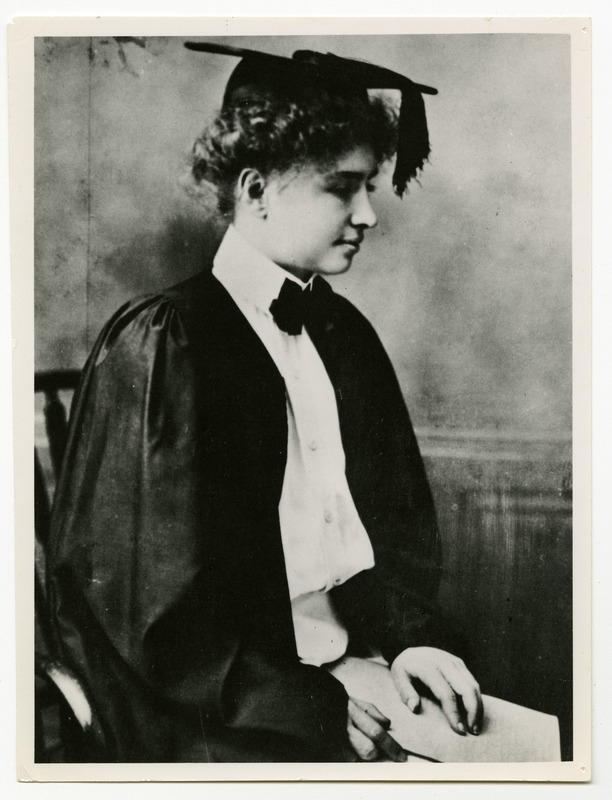Block 11 - Helen Keller

The following information is quoted from "Helen Keller-Ivy Green" website.
Helen
Adams Keller was born a healthy child on June 27, 1880, to Captain
Arthur H. and Kate Adams Keller of Tuscumbia. Her father, Arthur H.
Keller, was a retired Confederate Army captain and editor of the local
newspaper. Her mother, Kate Keller, was an educated young woman from
Memphis.
When Helen Keller was 19 months old, she was afflicted by an unknown
illness, possibly scarlet fever or meningitis, which left her deaf and
blind.
Helen was quite intelligent and tried to learn in her own way with
taste, feel and smell. She developed a rudimentary sign language with
which to communicate, but soon she realized that her family members
could communicate with their mouths instead of signing. This left her
isolated, unruly and prone to wild tantrums. Some members of her family
considered institutionalizing her.
Keller would later write in her autobiography, “the need of some
means of communication became so urgent that these outbursts occurred
daily, sometimes hourly.”
Seeking to improve her condition, in 1886 Helen and her parents
traveled from their Alabama home to Baltimore, Maryland, to see an
oculist who had had some success in dealing with conditions of the eye.
After examining Keller, he told her parents that he could not restore
her sight, but suggested that she could still be educated, referring
them to Alexander Graham Bell, who despite having achieved worldwide
fame with the invention of the telephone, was working with deaf children
in Washington, D.C.
After the visit Bell connected the Kellers to The Perkins Institute
and by March 3, 1887 Anne Sullivan came to Ivy Green to be Helen’s
teacher. The strong willed Sullivan, a recent graduate of the Perkins
school, met her match in Helen. The two worked together even though
Helen pinched, hit, kicked and even knocked out one of Anne’s teeth.
Once she had gained Helen’s trust, the real work could begin.
Anne began teaching Helen using finger spelling into the child’s
hand. Although Helen enjoyed this, she didn’t understand it truly until
Sullivan was steadily pumping cool water into one of the girl’s hands
while repeatedly tapping out the five letters in W-A-T-E-R. She
continued finger spelling while pumping the water again and again as
young Helen painstakingly struggled to break her world of silence.
Suddenly the signals crossed Helen’s consciousness with a meaning. By nightfall, Helen had learned 30 words using this process.
After Helen’s miraculous break-through at the simple well-pump, she
proved so gifted that she soon learned the fingertip alphabet and
shortly afterward to write. By the end of August, in six short months,
she knew 625 words.
By age 10, Helen had mastered Braille as well as the manual alphabet
and even learned to use the typewriter. By the time she was 16, Helen
could speak well enough to go to preparatory school and to college.
Sullivan interpreted lectures and class discussions to Helen. In 1904
she became the first deaf-blind person to graduate cum laude from
Radcliffe College.
Helen became one of history’s most remarkable women. She dedicated
her life to improving the conditions of the visually impaired and the
hearing impaired around the world, lecturing in more than 25 countries.
She helped to create the American Civil Liberties Union advocating for
the rights of women and of those with disabilities.
During her life she performed on the Vaudeville circuit, earned an
Oscar, was nominated for the Nobel Peace Prize, traveled to 25 countries
and met every President from Grover Cleveland to John F. Kennedy, 12 to
be exact.
Keller stopped her public appearances in 1961 after she suffered a
series of strokes. She was unable to attend the ceremony when President
Lyndon B. Johnson awarded her with the Presidential Medal of Freedom.
Keller’s
1968 funeral was held at the National Cathedral, and more than 1,200
people were in attendance. Alabama Senator Lister Hill gave the eulogy.
He said, “She will live on, one of the few, the immortal names not born
to die. Her spirit will endure as long as man can read and stories can
be told of the woman who showed the world there are no boundaries to
courage and faith.”
For this block you will need:
Background:
4) 2 1/2" x 4 1/2"
1) 4 1/2" square
4) 3 3/8" squares
Red:
4) 2 1/2" x 4 1/2"
Brown:
1) 2 7/8" x 24"
Sewing:
Cut 8) 2 7/8" squares from the brown strip. Cut each of these in half
diagonally. Sew two triangles to opposite sides of a 3 3/8" background
square. Press. Sew triangles to the remaining sides of the background
square. (Same method as used in block 10.)
Sew a 2 1/2" x 4 1/2" red strip with a 2 1/2" x 4 1/2" background strip along the length of the strips. Create 4 units.
Use the photo below to assemble the components and complete the block.
Happy Quilting!
Construction update:
The last of the sidewalk in front of our building was removed yesterday. Please feel free to enter through the back door during the construction. Thanks so much for your patience.







.jpg)





